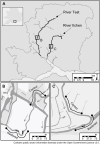Chalk stream restoration: Physical and ecological responses to gravel augmentation
- PMID: 39565789
- PMCID: PMC11578525
- DOI: 10.1371/journal.pone.0313876
Chalk stream restoration: Physical and ecological responses to gravel augmentation
Abstract
To mitigate the morphological and ecological impacts of direct (e.g. dredging) and indirect (e.g. damaged river function) sediment loss, gravel augmentation is commonly practiced in river systems globally. Despite this, the effectiveness of this practice remains poorly understood, especially in less often considered systems such as chalk streams which present uncommon conditions (e.g. low stream power, stable flow) and may respond to interventions in ways that differ from systems more commonly studied. This study quantified immediate (0-1 years) and short-term (1-2 years) physical and ecological responses to gravel augmentation at two English chalk stream restoration sites: Home Stream (HS; River Test) and East Lodge (EL; River Itchen). We quantified habitat (depth, velocity, substrate composition), cover of different macrophytes, and macroinvertebrate (before-after-control-impact) abundance and community structure. Restoration reduced depth and increased gravel cover in both sites and decreased the cover of filamentous green algae in HS. Macroinvertebrate communities became more dominated by silt-intolerant taxa, while abundance [HS only] and taxon richness increased 1-2 years post-restoration. Whilst the responses found were generally positive in light of the restoration goals, the effects varied across sites, post-restoration time periods and ecological groups, emphasising the need for the more holistic monitoring of restoration projects considering community-level responses at different sites and systems over ecologically relevant timescales. This will help inform on the generality and longevity of responses and provide the evidence needed to develop sound restoration practice.
Copyright: © 2024 Dolman et al. This is an open access article distributed under the terms of the Creative Commons Attribution License, which permits unrestricted use, distribution, and reproduction in any medium, provided the original author and source are credited.
Conflict of interest statement
The authors have declared that no competing interests exist.
Figures






References
-
- Gibling M. River Systems and the Anthropocene: A Late Pleistocene and Holocene Timeline for Human Influence. Quaternary. 2018; 1: 21. doi: 10.3390/quat1030021 - DOI
-
- Piqué G, Batalla RJ, Sabater S. Hydrological characterization of dammed rivers in the NW Mediterranean region. Hydrological Processes. 2016; 30(11): 1691–707. doi: 10.1002/hyp.10728 - DOI
-
- Galia T, Škarpich V, Ruman S. Impact of check dam series on coarse sediment connectivity. Geomorphology. 2021; 377: 107595. doi: 10.1016/j.geomorph.2021.107595 - DOI
-
- Foster I, Boardman J, Evans J, Copeland-Phillips R, Vadher A, Wright S, et al.. Anthropogenic sediment traps and network dislocation in a lowland UK river. Earth Surface Processes and Landforms. 2021; 47(1): 143–58. doi: 10.1002/esp.5235 - DOI
MeSH terms
LinkOut - more resources
Full Text Sources

